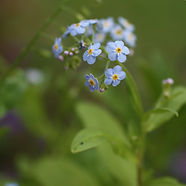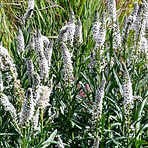Creating a Bog Garden
Bog gardens are wonderful for wildlife and attract many of the animals that visit ponds, such as damselflies, frogs and newts. A bog garden will increase the diversity of insects in your garden, which is also good news for the birds and bats.
We have clayey soils here and this can vary locally from patches of the garden that are well-drained to spots that regularly get water-logged making it hard for plants to grow. Improving drainage and soil structure can be hard work so why not go with the (lack of) flow and create a bog garden! You can select a part of your garden that naturally has boggy soil all year round, or you can create one.
To create a a new marshy area, bury an old pond liner or a large plastic sheet(s). Dig a hole to about 50cm deep (or just deeper than the liner if you are using a rigid liner), make a few drainage holes in the liner and place it in your hole. We used old compost bags for ours. Next add a thin (about 5cm/2 inches) layer of grit then back-fill the hole with the soil that you dug out. You can mix in a bit of compost or soil improver first if you want. And your new bog is ready for planting.

Plants for Moisture Retentive Soils
Before choosing your plants, it is worth noting down the characteristics of your site.
Is the soil:
-
Moist all year round but with enough drainage to prevent waterlogging;
-
Moist all year round but can get waterlogged in winter;
-
Usually moist but can get waterlogged in winter and can dry out during a drought;
-
Moist but well-drained and dries out in summer (not a bog, however, some bog plants can handle drier soils).
And is the light:
-
Sunny for most of the day and/or catches the hot afternoon sun;
-
Sunny for part of the day and shady for part of the day;
-
In shade for most of the day.
The table below identifies which of our bog plants thrive in each position. If you are browsing on your phone, click on the + sign to see the plants for sun, partial shade, and full shade.
We have many more non-bog plants that are well suited to the fourth soil type above (moist but well-drained) that you can find here.
In addition to the bog plants that we grow and sell, we also recommend looking at purple and yellow loosestrifes (will spread in the right conditions), reeds, goat's beard (Aruncus), leopard plant and gunnera (both huge!), calla lilies, Astrantia maxima, globeflower, Rodgersia, Iris versicolor and Iris ensata. For a tricky waterlogged spot in full shade, check out royal ferns.












